| |
|
|
 History
and Geography History
and Geography
èRectifying
Name
The Truku Tribe rectified
their name as the twelfth tribe of Taiwan
indigenous tribes on January 14, 2004.
At first, anthropologist divided the
Atayal Tribe into the Tayal and the Sejiq,
according to factors such as their legends of
origin and languages. The Sejiq call a person “Sedeg”.
Their legend has it that they originated from
the Baishi Mt. at the south eastern of Wushe
(now Hualien County Wanrong Township), but some
also say that they actually originated from the
Niumian Mt. in Puli.
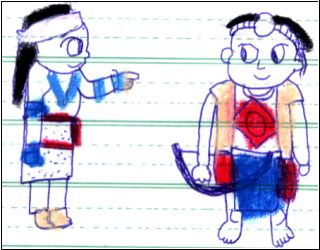 |
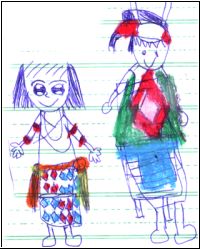 |
|
I am Truku
(illustrated by Yan-yu Yan) |
I am Truku
(illustrated by Pei-hsuan Hsu) |
During Qing Dynasty, the
Sejiq founded three tribes at now Nantou County
Ren-ai Township: Truku, Tkdaya, and Teuda.
Members in each tribe had strong and distinct
senses of their ethnic identification.
Sine the Atayal and the Sejiq
have different languages and social conventions,
later with the permission from the Executive
Yuan, the Truku of Sejiq became a different
tribe as Truku Tribe.

References:
1. The Geographic Distribution and an
Introduction to Taiwan Indigenous Peoples—Truku
Tribe. (2006.06). http://www.tacp.gov.tw/intro/nine/taroko/taroko1.HTM.
2. Walis, Yu, G.H. (2002). History of Taiwan
Indigenous Peoples—Atayal Tribe.. Nantou:
Taiwan Historica.
3. Li, Y.Y. (1963). ‘The Atayal in Nanao—Ethnological
Field Investigation and Research (1)’.
Academia Sinica Institute of Ethnology
Journal 5.
4. Hsu, M.C. (1989). The
Culture and the Conventions of the Truku of the
Atayal . Commissioned by the Construction
and Planning Agency, Ministry of the Interior,
researched by Academia Sinica Institute of
Ethnology.
5. Huang, C.H. (2000). ‘The Hunting Culture of
the East Sejiq’ . Compiled by Academia Sinica
Institute of Ethnology, 15: 1-104.
6. Tian, C.Y. (2001). Taiwan Indigenous
Peoples—Atayal Tribe. Taipei: Taiyuan
Publishing.
7. Liao, S.C. (1977). ‘The Migration and
Distribution of the East Sejiq of the Atayal
(1)’. Collected Papers of Academia Sinica
Institute of Ethnology 44.
èDistribution
Truku Tribe migrated from
Wushe of Ren-ai Township in Nantou County to
Liwu River and Mugua River in the northern
Hualien County about 300 years ago.
Traditionally, Truku Tribe was widely
distributed over the mountainous region of
eastern Taiwan at the river terraces, plateaus,
and piedmont along the coast of the following
rivers: Heping River, Liwu River, Mugua River,
Chiyagan River, Wanli River, Taiping River, and
Lakulaku River.
According to the Japanese
scholar Narazaki in The development of the Truku
aborigine, there were 96 Truku villages or
communities in 1917. However, after the Wushe
Incident in 1930, the Japanese government, for
management reason, forced their communities in
Central Mountains to migrate to their current
residence during 1931 to 1937. Furthermore, in
order to weaken their tribal power and prevent
anything like the Wushe Incident from happening,
the Japanese government also mixed the Truku
residences with that of other tribes
The current distribution
of the Truku is, roughly, between Heping
River and Taiping River, distributed over
Songlin, Lushan, Chingguan of Nantou County
Ren-ai Township; and Hualien County Shioulin
Township and Wanrong Township, Chosi
Township Lishan Village, and Chi-an Township
Chingfeng Village, Nanhua Village, and
Fuhsing Village.
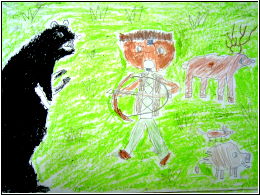 |
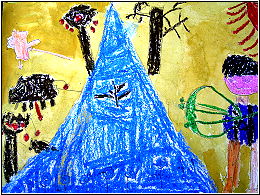 |
|
Hunting (illustrated by Meng-sheng
Chiou) |
Hunting (illustrated by Jie-sheng
Deng) |

References:
1. The Geographic
Distribution and an Introduction to Taiwan
Indigenous Peoples—Truku Tribe. (2006.06).
http://www.tacp.gov.tw/intro/nine/taroko/taroko1.
HTM.
2. Liao, S.C. (1977). ‘The
Migration and Distribution of the East Sejiq of
the Atayal (1)’. Collected Papers of Academia
Sinica Institute of Ethnology, 44.
3. Pan, C.D. (2003). ‘“The
Development of Mountainous Areas and the
Comforting of Barbarians” of Late Ch’ing Dynasty
and the Change of Interest of Taiwan Truku’, The
Historical Cultivation 9: 49-70. Taipei:
Graduate Institute of History, National Taiwan
Normal University.
 Languages
and Culture Languages
and Culture
Language is the most
important core of a tribe. Truku Tribe
successfully rectified its name as a tribe
precisely because their language is different
from the language of Atayal Tribe.
The following is an introduction to the
basic pronunciation of the Truku language
according to The Written System of Aboriginal
Languages published by Ministry of Education,
and a list of Truku language’s alphabet and
phonation.
Table 1: The Written System
of Truku Languages
|
19 consonants: |
|
Places and Manner of Articulation |
Script |
The International Phonetic Alphabet |
Places and Manner of Articulation |
Script |
The International Phonetic Alphabet |
|
Bilabial Plosives
(voiceless) |
p |
p |
Velar fricative
(voiceless) |
x |
x |
|
Bilabial plosive
(voiced) |
b |
b |
Pharyngeal fricative
(voiceless) |
h |
ħ |
|
Apical
(voiceless) |
t |
t |
Bilabial nasal |
m |
m |
|
Apical
(voiced) |
d |
d |
Alveolar nasal |
n |
n |
|
Velar plosive
(voiceless) |
k |
k |
Velar nasal |
ng |
ŋ |
|
Velar plosive
(voiced) |
g |
g |
Alveolar tap |
r |
ſ |
|
Uvular plosive
(voiceless) |
q |
q |
Alveolar lateral approximant |
l |
l |
|
Alveolar affricate
(voiceless) |
c |
ts |
Bilabial semivowel |
w |
w |
|
Alveolar affricate
(voiced) |
j |
ĵ |
Palatal semivowel |
y |
j |
|
Coronal sibilant
(voiceless) |
s |
s |
|
|
|
|
5 vowels: |
|
Places and Manner of Articulation |
Script |
The International Phonetic Alphabet |
Places and Manner of Articulation |
Script |
The International Phonetic Alphabet |
|
High front vowel |
i |
i |
Back close vowel |
u |
u |
|
Central mid vowel |
e |
ә |
Back mid vowel |
o |
o |
|
Central open vowel |
a |
a |
|
|
|

References:
The Written System of
Aboriginal Languages (Dec. 15, 2005). Tai-Yu-Tze-Di#0940163297,
Yuan-Min-Chiao-Tze-Di#09400355912. Taipei:
Ministry of Education, Council of Indigenous
Peoples, Executive Yuan. http://www.edu.tw/files/list/M0001/aboriginal.pdf
 Social
System Social
System
A traditional Truku society’s
core is their belief of their ancestral spirits.
The most important element of a Truku social
system is Gaya, which sustain their people’s
survival.
Gaya includes the culture of
living norm, evaluative judgments, etc., which
the Truku follow in their lives. The term “Gaya”
means customs, or conventions, which includes
laws, moral view, taboos, rituals, customs, and
norms, etc.
Gaya also means “a ritual
group”, families from the same ritual group
would hold various agricultural ceremonies at
the same day. They would also plant seeds and
harvest at the same day. So a Gaya is a group of
Truku people that lives, holds ceremonies,
complies with taboos, and bears penalty
together. Whenever there is a festival, all
members of a Gaya would sing, dance, drink, and
pray to the ancestral spirits for an abundant
harvest. After a person dies, his/her soul will
reunite with his/her ancestors of the same Gaya.
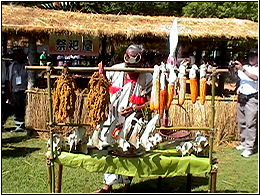 |
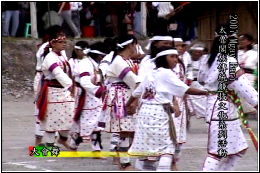 |
|
A priest praying to the ancestral
spirits for an abundant harvest |
A communal dance after a sacrificial
ritual |
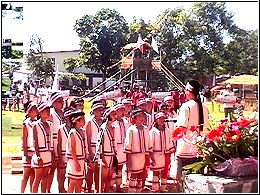 |
 |
|
A singing performance after a
sacrificial ritual |
A musical performance after a
sacrificial ritual |
For the traditional Atayal
people (Truku people), all the behaviours of a
person throughout his/her whole life must obey
Gaya. Disobedience will anger ancestral spirits
and incur penalty to oneself or other members in
the same Gaya. So the chief, priest, and
priestess of a Gaya are responsible for
overseeing all members obeying Gaya.
Facial tattoos are the
symbols of fame for traditional Truku people.
Only after many successful hunts can a man has
tattoos painted on his forehead and his jaw; a
woman must know how to weave cloth before she
can have tattoos painted on her forehead and
cheeks. Only a person with a complete facial
tattoo can marry.
Due to the beliefs and
conventions of the traditional Truku society,
they had a head hunting convention. The Truku
thinks that head hunting is a sacred and
manhood-proving action. Normally they would not
go head hunting, unless they were attacked by a
foreign tribe, or they wanted to take revenge,
or they wanted blessing from gods during a
disaster.

References:
1. Yu, G.H. (1981). ‘The Tribal Organization of
the Sejiq of the Atayal’. Collected Papers of
Academia Sinica Institute of Ethnology, 50:
91-110.
2. Liao, S.C. (1998). The Social Organization
of the Atayal. Hualien: Tzu Chi University.
3. Li, N.L., Tu, L.C., Chen, P.Y., edited by
Liu, H.Y. (2001). A Complete Guide to the
Sacrifice of Taiwan Aborigine. Taipei: Chang
Min Culture.
 Sacrificial
Ritual Sacrificial
Ritual
The Truku calls every
supernatural being “rutux”, which include
benevolent rutuxs (souls from people who died
naturally) and evil rutuxs (souls from people
who died unnaturally). They do not offer
sacrifice to evil rutuxs; but the benevolent
rutuxs (including ancestral rutux and some
others) are closely connected to their everyday
life and thus receive sacrifice.
In important ceremonies like wedding, ancestral
spirit sacrificial ritual and harvest
sacrificial ritual, all men from a Gaya or a
society will join a hunt. The hunting zone will
be far from their residence and cover a large
area; it will take a week or even a month. As a
result, the women will prepare enough food for
the hunter before the hunt. During the hunt, the
hunters will start from the peripheral or a part
of the peripheral of the hunting zone and chase
the preys to the centre. So it will require the
cooperation of the whole tribe, so as to
strengthen their tribal identification and the
cohesion of the Gaya.
èAncestral
Spirit Sacrificial Ritual
Ancestral spirit sacrificial ritual
signifies the core of beliefs of the whole
tribe, which is also the spiritual symbol to the
cohesion of the tribe. An ancestral spirit
sacrificial ritual consists of three parts:
admonition from an elder, history telling, and
the summoning of ancestral spirits.
A week before the ritual, the chief will send
members to weed the graveyard and start to
prepare the ritual. The ritual will begin with a
representative of the Gaya, with sacrifices such
as meat and millet cake clipped with bamboo
chopsticks, leading the tribal members to the
ritual site. After the chief have given an
admonition, he will, together with the
vice-chief, lead all the men from the tribe to
the ritual site. On their way to the site,
people will hold a touch and sacrifices in their
hands and call the names of their ancestors to
ask them to join the ritual. When they arrive,
they will still keep asking their ancestors to
join with fire.
After they arrive at the ritual site and stick
their bamboo chopsticks into the earth, the
chief will first pray to their ancestral
spirits, and then the representative, an elder,
or a prestige person from each Gaya will also
pray their ancestral spirits.
After the ceremony, the young will return first.
When they leave, they must go across a fire
pile, symbolizing that they are parting with
their ancestral spirit, and hoping to cleanse
themselves and to keep the calamity away. Older
people and the chief will stay there and talk
and drink with the spirits. The alcohol and
sacrifice that are left must be left on the
site.
èSeeding
Ritual
When the tribe is going to hold a Seeding
Ritual, people must steam the millet cakes for
the ritual at the early morning. Fires in one’s
home must not be extinguished. During the
ritual, these fires will be used to ignite the
touches. Two priests will then lead the people
to the field with millet cakes, alcohols, millet
tassels and small hoes.
They will first come to the field of one of the
priests, and dig a small area in the field for
the Seeding Ritual to pray to their ancestral
spirits for the successful sprouting of all the
seeds planted.
After the prayer, half of a piece of millet cake
will be put at the centre of the ritual field,
and then alcohols will be poured on it. And the
rest of the millet cakes and alcohols will be
shared by the two priests beside the field. And
then they will go to the field of the other
priest and repeat the same ritual.
èHarvesting
Ritual
After the millet matured and ready to be
harvest, each family will harvest a few tassels
of millet back home, and then hand one on the
tree and plant one in the field.After the
harvest finish, one tassel will also be put on
the roof of the barn.
On the early morning of the ritual day,
two tribal members will be picked to summon the
ancestral spirit and pray for good luck. When
the ceremony finish, all the people must leave
the site and must not turn back to look.
èHunting
Ritual
Before a hunting group sets out, two hunters
will go first and try to observe the flying
direction of the Sisils, in order to decide
whether to set out to hunt. When a group goes
hunting in the mountain, members will setup a
hunting hut at the destination and rest for a
night. They will start hunting the next day.

References:
1. Chou, Y.E. (2001). The Hunting Culture of
the East Sejiq and the Management of National
Parks. Taroko National Park Administration,
Construction and Planning Agency, Ministry of
the Interior.
2. Yu, G.H. (1981). ‘The Tribal Organization of
the Sejiq of the Atayal’. Collected Papers of
Academia Sinica Institute of Ethnology, 50:
91-110.
3. Liao, S.C. (1998). The Social Organization
of the Atayal. Hualien: Tzu Chi University.
4. Li, N.L., Tu, L.C., Chen, P.Y., edited by
Liu, H.Y. (2001). A Complete Guide to the
Sacrifice of Taiwan Aborigine. Taipei: Chang
Min Culture.
 Historic
Events Historic
Events
Truku Campaign:
Due to the Treaty of Maguan, The Japanese forces
entered Taiwan in 1895. They rose many battles
against the Truku in the eastern Taiwan, who did
not submit to the Japanese, in the 18 years
between 1898~1916.
Among these battles, the “Military Action
against the Truku” in May of 1914 is the longest
and the biggest. The Japanese deployed totally
more than 20,000 members from the land force and
the armed police, equipped with the latest type
of firearms, attacking the Truku from the east
and the west simultaneously. The force attacked
from the east was further divided into two
sub-forces at Tongmen and Wenlan: a western
sub-force and a northern sub-force; the western
force was led by the Taiwan governor, Kawagoe,
himself, started from Puli, through Wu She,
Chuifeng (now Cuifeng), they arrived at Hehuan
Mt. (about the now winter training centre of the
land force) and founded the “Commend Centre of
the Campaign”. His force consisted of almost ten
thousand members, overseeing the Truku together
with the eastern force coming from Hualin port,
which, through Xincheng, arrived at Wuxi.
In the meantime, the Truku had only 2300
fighters, equipped with simple hunting bows, to
defend against the well-equip Japanese force.
They surrendered after 60 days of fierce
battles. Both sides had heavy casualties, and
the Truku paid for the campaign bitterly.

References:
Bulletin, New Aspen Rest Stop, Taroko National
Park, Central Cross-Island Highway, Tai-8, 143
km mark
 Myths
and Legends Myths
and Legends
|
【From
Millets to Sparrows】
Once upon a time,
everything in the world is good friends
to the Truku. The Truku does not need to
work hard for decent livings. For
example, when they were hungry, they
could just come to the millet field and
pick one granule of millet, which would
become a millet meal enough for a whole
family after cooked.
However, one day, such decent lives were
destroyed.
There was a very lazy
woman who thought only of how to avoid
working. One day, it was her turn to
cook. She came to the millet field and
looked at the millets. Suddenly she came
up with an idea, “If one granule of
millet can be turned into a meal, then I
can have a lot of meals with a lot of
millets! So I do not need to cook
anymore!” She then picked a lot of
millet immediately and threw them all
into a pot and cooked them.
She waited and waited, but still no
smell of a ready meal. Out of curiosity,
she opened the cover of the pot.
Unexpectedly, all the millets in the pot
became sparrows and flow away, singing,
“Lazy human! From now on you need to
farm hard to have millets! In the
harvest seasons, we will even come to
steal your millets!” Since then, the
Truku people have to farm hard and hunt
hard to feed themselves.
References:
Story by Rimui, illustrated by Meimei (2002).
The Atayal: The Judgement of the Rainbow Bridge.
Taipei: New Naturalism.
 |
【Sisil
the Spiritual Bird】
Once upon a time, there was a
huge rock on top of a mountain. This rock was
big and heavy, sitting securely on the mountain
top. Usually there were birds playing on the
rock happily.
One day, a bird suggested,
“Whoever can move this rock, we will
call him/her king.” Then, every bird
came and tried to push the rock down
from the mountain top, though, not
any of them succeeded. Even the two
strongest and most powerful birds,
Kaboji and Boshi, can only budge it
with all of their power.
At that time, Sisil, who had been
watching quietly, came and attempted
to move the rock. But Sisil was
small and thin, could it move the
big and heavy rock? Out of surprise,
Sisil came slowly to the rock and
kicked it; the rock fell to the
bottom of the mountain. No one could
believe their eyes, but since then,
Sisil has become the king of birds.
When Sisil flow to the sky, it told
people, “Hereafter, you should
listen to my sounds to predict the
future.” Afterward, the Truku will
listen to the Sisil’s sounds to
predict the future whenever they are
going to make an important decision,
hunt, or head hunt.
Taboo
1. If Sisil’s sounds are slow and clear, it is
an auspicious sign; if they are not clear, it is
an ominous sign.
2. It is an auspicious sign if a
Sisil keeps hovering and singing on
the right of a hunter’s advancing
direction; if it is on the left, the
hunter must stop advancing, and may
continue to go forward only after
the Sisil flies to the hunter left.
3. It is an ominous and dangerous
sign if a Sisil flies across a
hunter from the left or from the
right. The hunter must return
immediately and reschedule the hunt.
4. It is an ominous sign if a Sisil
flies and sings from the right to
the left, and then back to the
right.
References:
1. Liu, Y.L.
(2001). A Research on the Oral
Stories of the Sejiq of Taiwan.
Master Thesis of Folk Literature at
National Hualien Normal University
(unpublished).
2. Sayama (1918).
Reports on the Investigation of
the Barbarians 3—Shaji Trib.
Provisional Taiwan Convention
Investigation Commission.
3. Sejiq People
Forum –A Research on Sisil http://groups.google.com.tw/group/sediqyouth/web/sisil
4. Digital Museum of Taiwan
Indigenous Peoples –Their Cultures
of Tradition, Ritual and Life—The
Truku. http://www.dmtip.gov.tw/Aborigines/Article.aspx?CategoryID=3&ClassID=9&TypeID=20&RaceID=10

|
|
【Taboo
of Head Hunting】
Head Hunting, an
activity which the Truku think as holy
and manhood-proving, has already been
cancelled a hundred years ago.
Traditionally, a Truku would not go head
hunting easily. They would only do this
when they were attacked by foreign
tribes, they needed to take revenge, or
they pray to ancestral spirits for
blessing in disasters.
A head hunt was usually led by the chief
or a priest with several members. Before
they set out, they had to have three
divinations of dreaming and bird-sign
reading. They would set out only when
there was auspicious sign. If there was
an ominous sign, they would return.
Until members of the head hunt team
returned home, their family members had
to keep the fire for cooking alive, and
they had to avoid any handicraft or
joke.
When the head hunt
team approached the enemy, the team
member in heroic suit, who had
experience in head hunting, would
inspect the enemy first. If the team
successfully attacked and killed the
enemy without casualty, the head of the
enemy would be carried by a young member
and sang on their way home. Members who
hunted a head would be welcomed by tribe
members and be dressed in heroic suit.
When they arrived the
tribe, if someone got sick, they would
swayed the enemy head above the patient,
and they believed s/he would recovered
shortly. On the first day, the family
that hunted a head would feed the head
with distiller’s grains, pork, and cake,
and dance. On the second day, the head
would be brought to the home of the
chief or a priest. On the third day,
other team members would feed the head
with pork and alcohol. Finally the head
would be put on a skeleton shelf,
decorated with grass-root ornaments. The
chief would then summon the soul of the
enemy, “Through our power you are
brought to our tribe. Perhaps your whole
family is sad, but now you have already
eaten many foods happily, please welcome
your whole family here.” The tribe would
then celebrate for five to six days.
But if someone was hurt or killed, the
team would undress at night and quietly
go back to the tribe, and knock on the
doors of their house with stones. They
would then go inside the houses quietly.
They would never use the knives they
used during the hunt again, and the
person who initiated the hunt had to
compensate the family of the dead or the
wounded.
References:
1. Li, N.L., Tu, L.C., Chen, P.Y.,
edited by Liu, H.Y. (2001). A
Complete Guide to the Sacrifice of
Taiwan Aborigine).
Taipei: Chang Min Culture.
2. Digital Museum of Taiwan Indigenous
Peoples –Their Cultures of Tradition,
Ritual and Life—The Truku. http://www.dmtip.gov.tw/Aborigines/Article.aspx?CategoryID=3&ClassID=9&TypeID=20&RaceID=10
 |
|
|
|